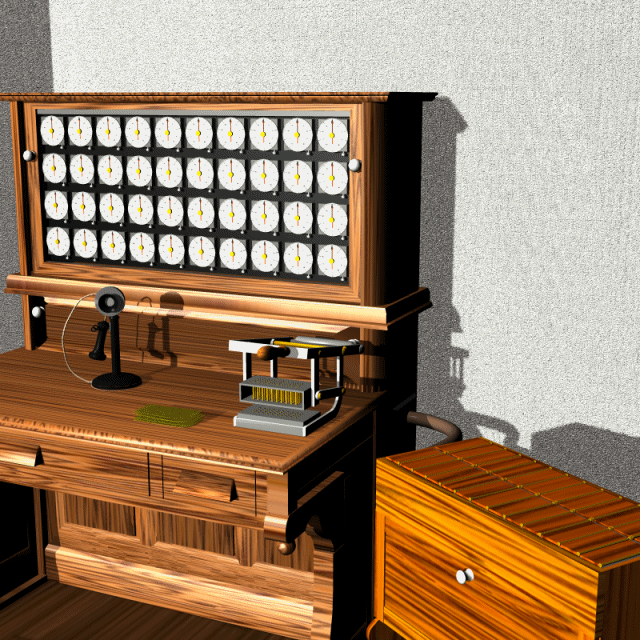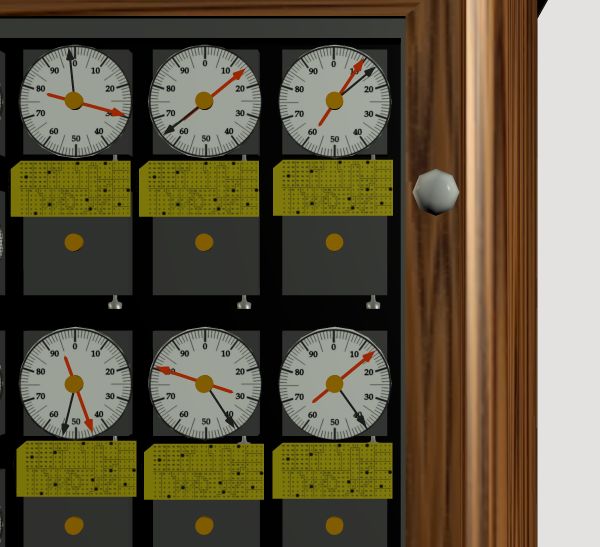Thursday, March 14, 2019
Nope, backwards as usual.
Via uCatholic.com:
Nope. Didn't begin with Steve. Didn't begin with Bill Gates. Didn't begin with Babbage either. Babbage was an interesting dead-end, rediscovered later but not part of the family tree. It certainly didn't begin with Turing, as New Stalinist is trying to claim this week. Turing's "tape machine" was invented long after the discipline was well developed. His little abstract Gedankenexperiment didn't explain anything and didn't play any part in the development of actual computers. Merely an interesting detour. Much like the number-theory "foundation" of mathematics developed by Hilbert, Peano, et al, which was not a foundation at all, just a tacked-on filigree. Thousands of teachers have ruined millions of students by treating the filigree as a footing.
No, computing began in the dull and obvious location, Herman Hollerith's 1890 census tabulator. And the functions in that machine are still the dominant functions of modern computers, descended in a direct line from Hollerith. It's IBM all the way down, with considerable help from DEC and HP and Bell Labs. Steve and Bill contributed hugely in the commercial realm, making the computer seem cool and necessary; but they added nothing meaningful to the technology.

Here's a simple animation of Hollerith's 1890 Census machine. [Polistra and Happystar wanted to get in the picture, but they blocked the view of the important parts. So you'll have to imagine a person operating the press and moving the cards.]
This 1890 Tabulator only automated the most tiresome and error-prone stage of the process, counting the holes and sorting cards into 'pre-programmed' categories. When you pull the handle of the press, a grid of spring-mounted needles tries to poke through all the hole locations. Where a hole is actually punched, the needle drops through to make contact below, closing a circuit that leads to the corresponding dial above. An electromagnet ratchets the Ones dial forward one step, and the Tens dial follows by reduction gearing. Much like the escapement in a clock.
If this particular combination of holes corresponds to one of the programmed combinations, the Sorter pops an appropriate door open. You'd then take the card, drop it into the one open door, and close the door.
The programming of combinations was done mainly by soldering and unsoldering dozens of wires for each setup! There were a few switchboard-style plugin choices, which would have been like user-selected variables, not like actual software. So my animation is arbitrary, not trying to make any real combinations, showing only that the dials increment and a different door opens for each card.
This process was clearly too 'manual' even by the standards of the time, with humans performing several steps that were easily mechanized. After 1890 Hollerith went commercial and quickly developed various ways to feed and read cards automatically, then carry them into appropriate slots. He also began to add more calculation and programming abilities.
= = = = =
The animation doesn't include the first step: Cards were punched using a pantograph-like machine, or by hand, to register the information from the handwritten census forms. One card for each person, with labeled hole locations for male, female; child, adult; white, colored; renter, owner; and so on.
Hollerith borrowed the punch idea from an early use of biometrics on Mississippi steamboats. Tickets contained a list of descriptors: race, gender, height, facial hair, etc. The conductor punched the passenger's description at boarding, then the passenger could reboard at various ports without having to pay a new fare. = = = = = END PARTIAL REPRINT. And there it is. Hollerith was COUNTING occurrences of WORDS, just as Busa wanted to do. By 1949 the myth of numerical "computing" had taken over from Hollerith's original purpose, so the concept of a sorter for verbal concepts was alien to Watson. = = = = = Speculative: A contemporary inventor could have gone a lot farther in the verbal direction with existing technology. Some pre-Morse telegraphs had keyboards that automatically sent a code when each letter was struck, and printers that typed the letter when its code was received. A counter and sorter could have been placed in the pulse stream, outputting or registering an indication for each pre-programmed word. I imagine a setup like this, where each card is punched for a word, and the incoming stream scans across all cards at once, with each dial registering when the sequence matches the punches on its card. This would have been commercially useful for business telegrams, where most sentences were reduced to peculiar fixed-length 'words'. The sorter could read the incoming stream and automatically place orders for the coded products!
The index typewriter, invented in 1881, was closely related to Hollerith's pantograph mechanism, and could have inspired a way of representing sentence structure on a card.
This would have been commercially useful for business telegrams, where most sentences were reduced to peculiar fixed-length 'words'. The sorter could read the incoming stream and automatically place orders for the coded products!
The index typewriter, invented in 1881, was closely related to Hollerith's pantograph mechanism, and could have inspired a way of representing sentence structure on a card.
The computer was originally invented to do just that: compute. Numerical calculations were its sole intended purpose, and words were never in the realm of consideration as something to be used by computers. If not for Thomas Aquinas and a Jesuit priest, you might not have been able to read this article. In 1949, Father Busa went on a trip to the United States, and met with IBM founder Thomas Watson. In the magnate’s New York office, Watson listened to the Jesuit’s request to add the use of words to the recently-invented computer in order to complete his magnum opus. Watson replied at the seemingly-incredulous request: “it is impossible for the machines to do what you are suggesting – you are claiming to be more American than us.” Busa challenging IBM resulted in the invention of hypertext, textual references to pieces of information on a computer. 57 printed volumes of the Index Thomisticus and a CD-ROM were eventually released.Wrong from the exact start. Hollerith's original 1890 machine was originally invented to sort words, not calculate numbers. Each hole in the punch card was a textual reference to pieces of information. Partial reprint from my overlong description: = = = = = START PARTIAL REPRINT: Polistra has always been annoyed at the Apple-based revision of technical history. The Great Steve Jobs rewrote the history of computing so it began with The Great Steve Jobs. Everything He touched became a landmark.
Nope. Didn't begin with Steve. Didn't begin with Bill Gates. Didn't begin with Babbage either. Babbage was an interesting dead-end, rediscovered later but not part of the family tree. It certainly didn't begin with Turing, as New Stalinist is trying to claim this week. Turing's "tape machine" was invented long after the discipline was well developed. His little abstract Gedankenexperiment didn't explain anything and didn't play any part in the development of actual computers. Merely an interesting detour. Much like the number-theory "foundation" of mathematics developed by Hilbert, Peano, et al, which was not a foundation at all, just a tacked-on filigree. Thousands of teachers have ruined millions of students by treating the filigree as a footing.
No, computing began in the dull and obvious location, Herman Hollerith's 1890 census tabulator. And the functions in that machine are still the dominant functions of modern computers, descended in a direct line from Hollerith. It's IBM all the way down, with considerable help from DEC and HP and Bell Labs. Steve and Bill contributed hugely in the commercial realm, making the computer seem cool and necessary; but they added nothing meaningful to the technology.

Here's a simple animation of Hollerith's 1890 Census machine. [Polistra and Happystar wanted to get in the picture, but they blocked the view of the important parts. So you'll have to imagine a person operating the press and moving the cards.]
This 1890 Tabulator only automated the most tiresome and error-prone stage of the process, counting the holes and sorting cards into 'pre-programmed' categories. When you pull the handle of the press, a grid of spring-mounted needles tries to poke through all the hole locations. Where a hole is actually punched, the needle drops through to make contact below, closing a circuit that leads to the corresponding dial above. An electromagnet ratchets the Ones dial forward one step, and the Tens dial follows by reduction gearing. Much like the escapement in a clock.
If this particular combination of holes corresponds to one of the programmed combinations, the Sorter pops an appropriate door open. You'd then take the card, drop it into the one open door, and close the door.
The programming of combinations was done mainly by soldering and unsoldering dozens of wires for each setup! There were a few switchboard-style plugin choices, which would have been like user-selected variables, not like actual software. So my animation is arbitrary, not trying to make any real combinations, showing only that the dials increment and a different door opens for each card.
This process was clearly too 'manual' even by the standards of the time, with humans performing several steps that were easily mechanized. After 1890 Hollerith went commercial and quickly developed various ways to feed and read cards automatically, then carry them into appropriate slots. He also began to add more calculation and programming abilities.
= = = = =
The animation doesn't include the first step: Cards were punched using a pantograph-like machine, or by hand, to register the information from the handwritten census forms. One card for each person, with labeled hole locations for male, female; child, adult; white, colored; renter, owner; and so on.
Hollerith borrowed the punch idea from an early use of biometrics on Mississippi steamboats. Tickets contained a list of descriptors: race, gender, height, facial hair, etc. The conductor punched the passenger's description at boarding, then the passenger could reboard at various ports without having to pay a new fare. = = = = = END PARTIAL REPRINT. And there it is. Hollerith was COUNTING occurrences of WORDS, just as Busa wanted to do. By 1949 the myth of numerical "computing" had taken over from Hollerith's original purpose, so the concept of a sorter for verbal concepts was alien to Watson. = = = = = Speculative: A contemporary inventor could have gone a lot farther in the verbal direction with existing technology. Some pre-Morse telegraphs had keyboards that automatically sent a code when each letter was struck, and printers that typed the letter when its code was received. A counter and sorter could have been placed in the pulse stream, outputting or registering an indication for each pre-programmed word. I imagine a setup like this, where each card is punched for a word, and the incoming stream scans across all cards at once, with each dial registering when the sequence matches the punches on its card.
 This would have been commercially useful for business telegrams, where most sentences were reduced to peculiar fixed-length 'words'. The sorter could read the incoming stream and automatically place orders for the coded products!
The index typewriter, invented in 1881, was closely related to Hollerith's pantograph mechanism, and could have inspired a way of representing sentence structure on a card.
This would have been commercially useful for business telegrams, where most sentences were reduced to peculiar fixed-length 'words'. The sorter could read the incoming stream and automatically place orders for the coded products!
The index typewriter, invented in 1881, was closely related to Hollerith's pantograph mechanism, and could have inspired a way of representing sentence structure on a card.Labels: Alternate universe, Morsenet of Things
